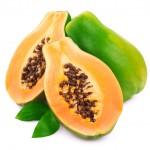While consumers in the United States have come to embrace the introduction of genetically-modified products, papaya-loving Hawaiians had less of a choice when an agricultural crisis struck the state in the 1990s.
A tiny insect culprit -- the aphid -- endangered the crop, but scientific advances set the stage for the "SunUp" and "Rainbow" papayas, named for their skin color, to become the first commercialized GM fruits in the United States. Even now farmers there flinch when they hear that word, "aphid."
In the 1950s, swarms of these small but formidable bugs swept the Hawaiian island of Oahu -- then the state's major papaya producer. As the aphids fed on the island's papaya fields, they transferred the now infamous "papaya ringspot virus" -- or PRV -- to the plants. When the PRV-infected plants festered, their leaves became distorted; yellowing and cupping upward, then thinning to resemble shoe laces. After an extended period, many large rings (hence the name "ringspot") would cover the infected fruit.
The papaya crop withered and died soon after. After the first plague, papaya farmers moved their business to Hilo, Hawaii's largest city, but the aphids soon followed. In the 90s, the pests stalked the farmers yet again to the district of Puna. By the time a solution was found in 1998, the unstoppable aphids and their virus had cut papaya production almost in half. The beloved and traditional fruit among Hawaiians and around the world, the papaya is a juicy dessert bought fairly cheaply in the Hawaiian market. And the majority of Hawaiian papaya farmers -- mostly high-school-educated, Filipino men -- depend on the fruit for at least part of their family's income. So the spread of PRV threatened not only the papaya consumer (through rising prices), but farmers' livelihoods. But a fellow Hawaiian soon came to the rescue.
First, some background. Born and raised in North Kohala, Dennis Gonsalves studied to be a plant virus specialist, becoming a plant pathologist and professor at Cornell University in 1977. Struck by PRV's impact when visiting his hometown a year later, Gonsalves dedicated himself to finding a solution. In 1989, Gonsalves and other scientists had their sights set on genetic engineering to develop a virus-resistant papaya cultivar. Gonsalves isolated the virus' coat protein and -- with the assistance of Dr. Jerry Slightom -- modified it for plant use.
Using fellow Cornell professor John Sanford's recently developed "gene gun," the team "shot" thousands of these virus-encoded cells into PRV-infected papaya tissue. In doing so, they hoped that some of this tissue would eventually incorporate -- and adapt a resistance to -- the virus DNA. Gonsalves's team missed the mark for three years before finally nailing the bullseye, creating the first PRV-resistant plant tissue in 1992. The University of Hawaii's Dr. Richard Manshardt then used traditional plant-breeding techniques to inbreed the resistant plant. This produced the true-breed, red-fleshed cultivar SunUp. But the papaya industry insisted that their product maintain its traditional yellow flesh, so Manshardt crossed SunUp with the original PRV-vulnerable "Kapoho" strain. Thus, the yellow hybrid Rainbow was born.
Today the majority of Hawaiian papaya farmers welcome the genetically-modified papaya. In 2014, these farmers produced over 23 million pounds of the sweet fruit -- primarily Rainbow and SunUp. Not only do the Rainbow and SunUp plants outweigh, in ounces, the elder Kapoho and Sunrise by 50 percent, but they're sweeter, juicier and they produce a more mild aroma than the original PRV-vulnerable strains.
Ultimately, some Hawaiians who were once skeptical of genetic modification witnessed firsthand how science, and the pioneering efforts of scientists, could save a crop, as well as an essential industry, while enriching lives at the same time.



